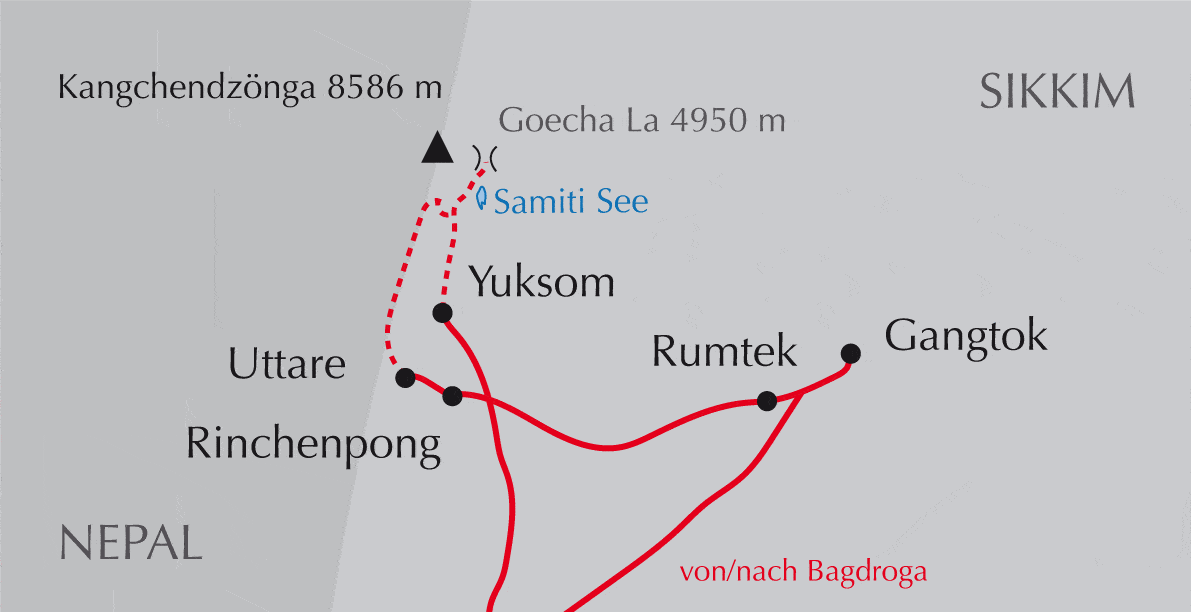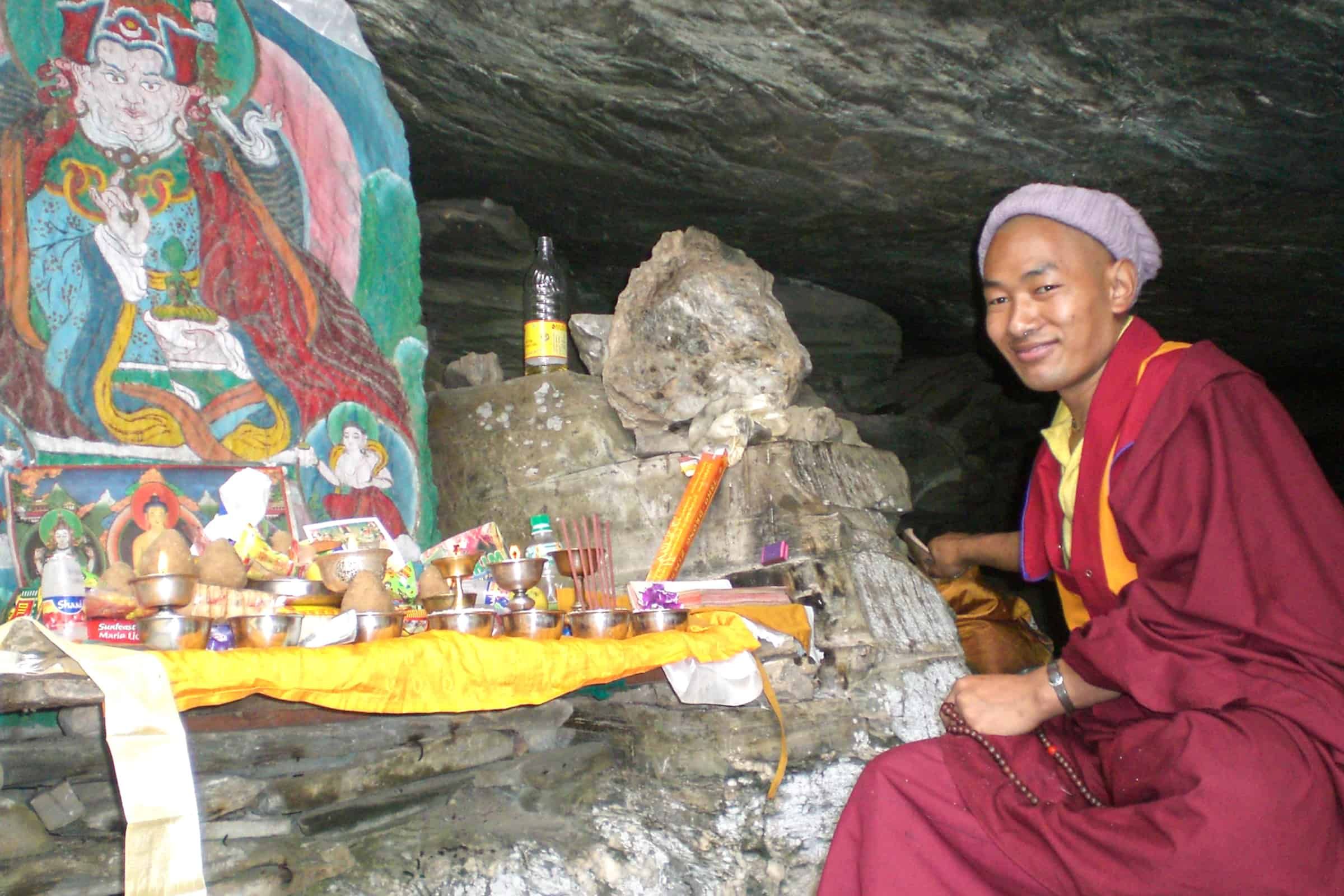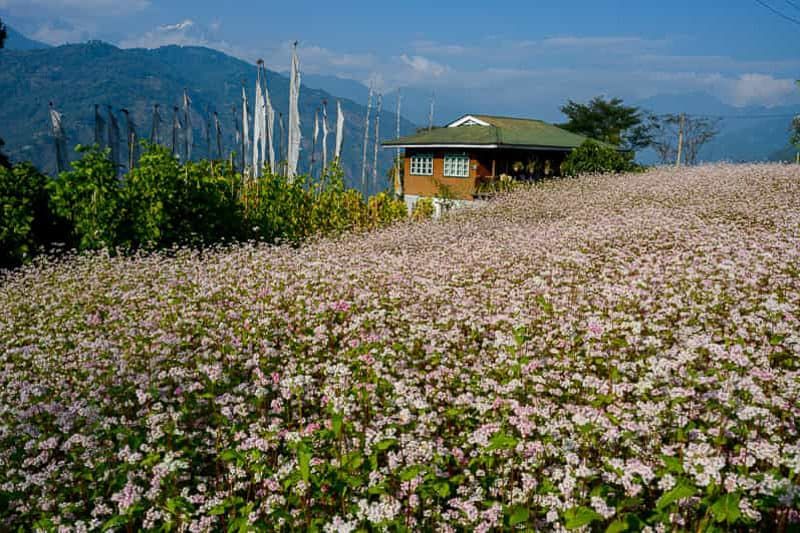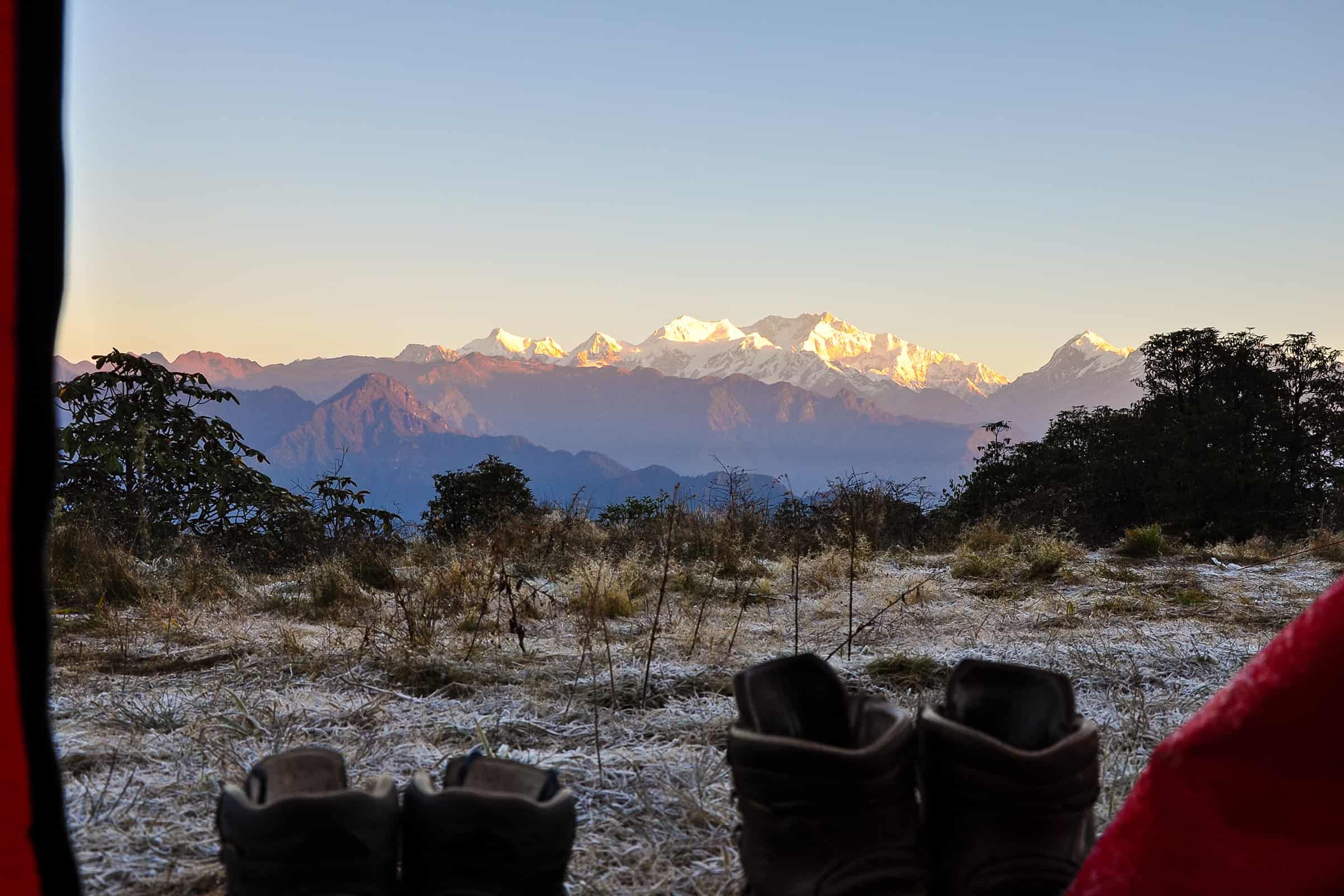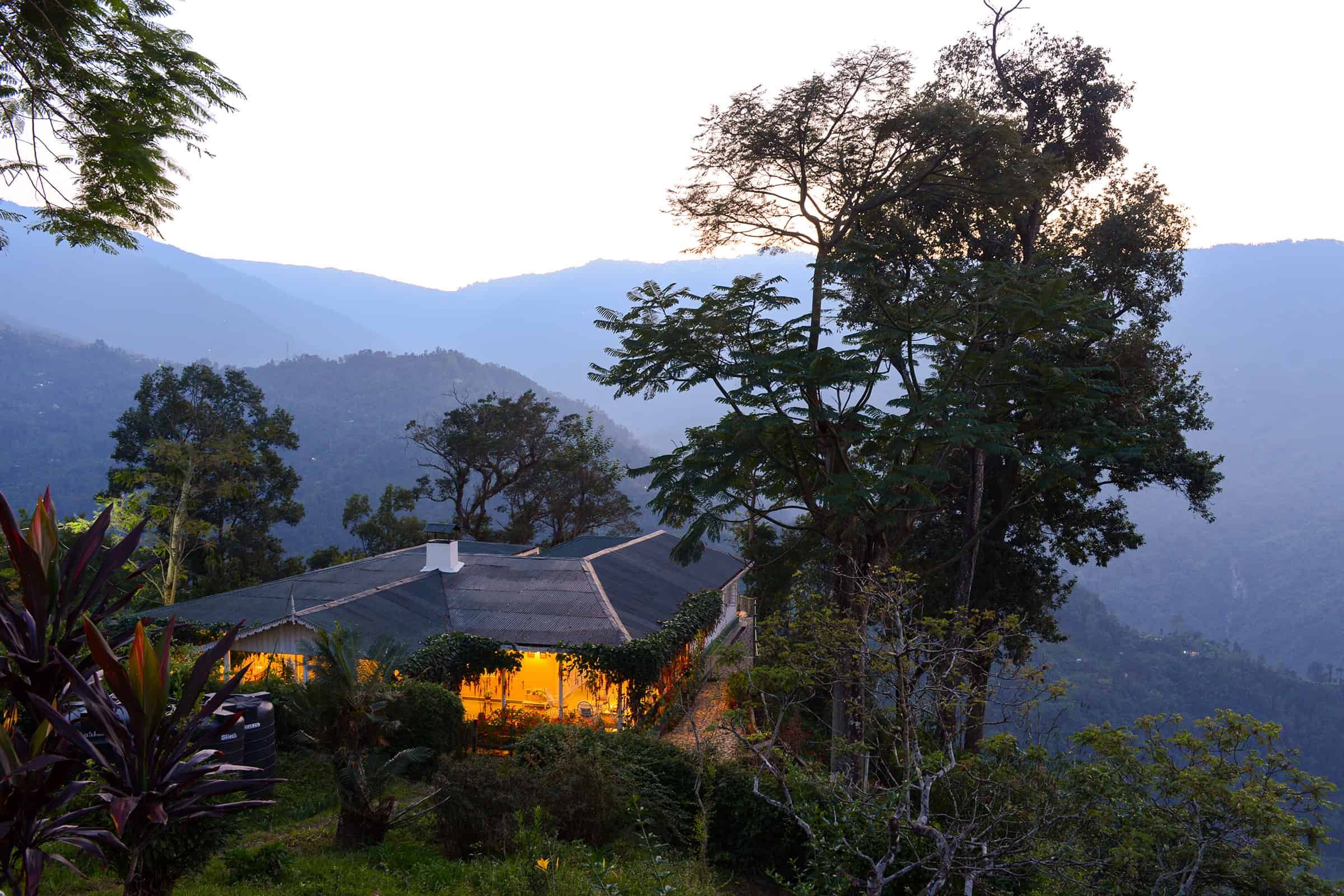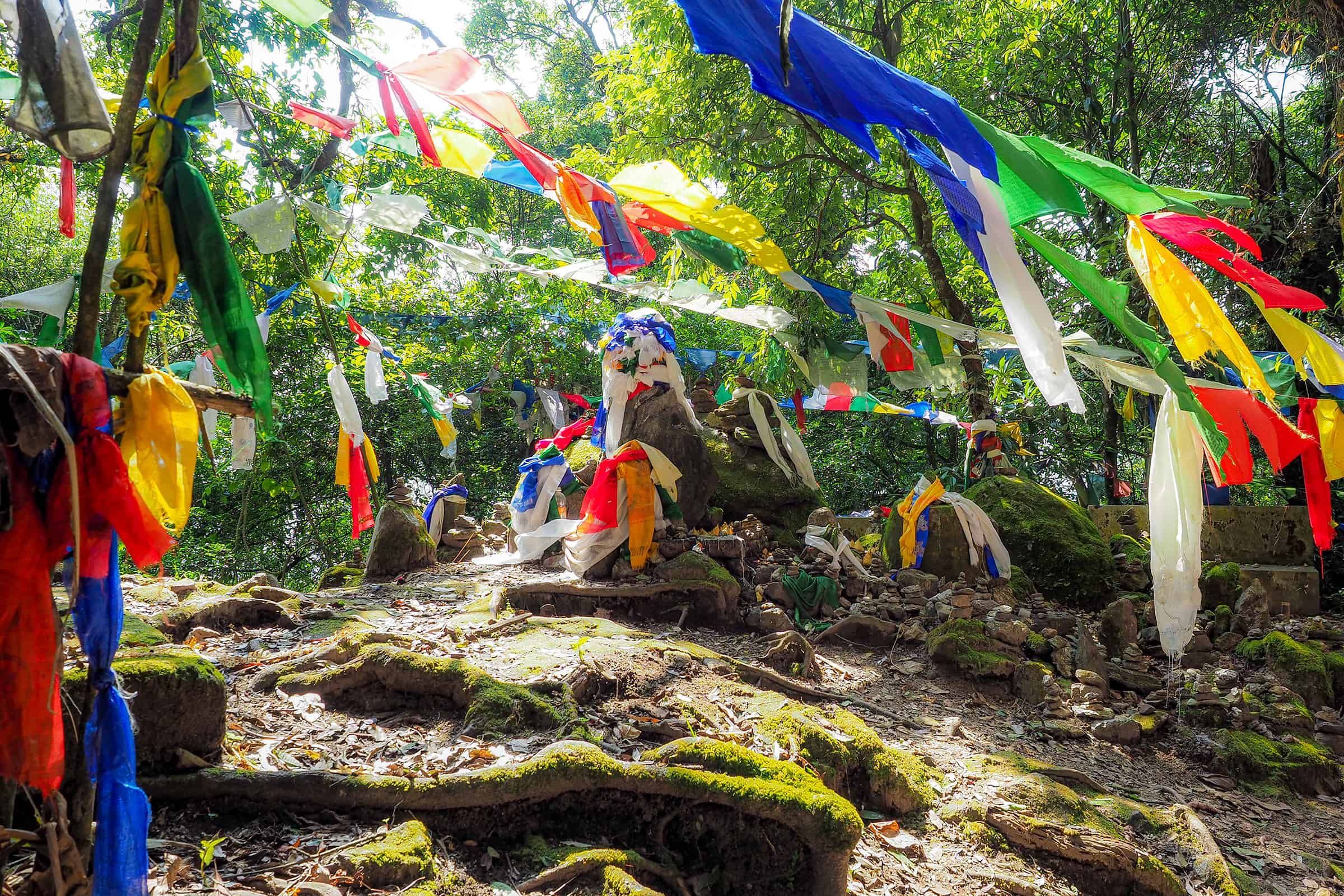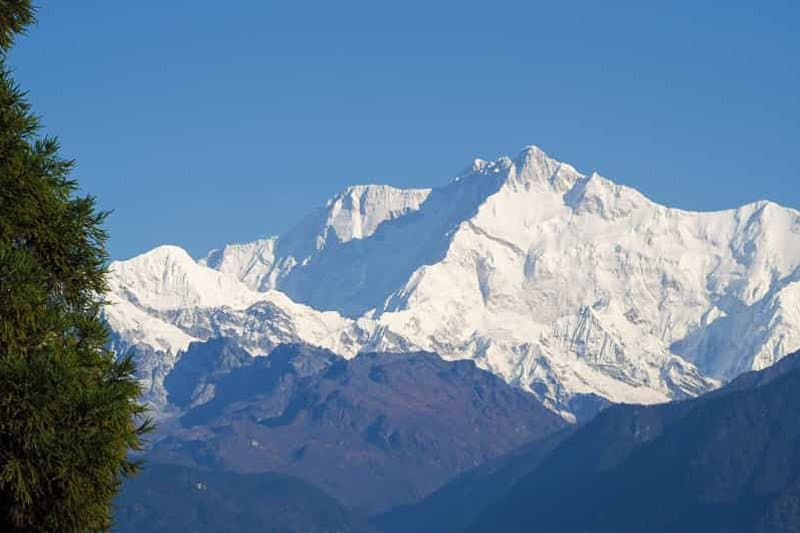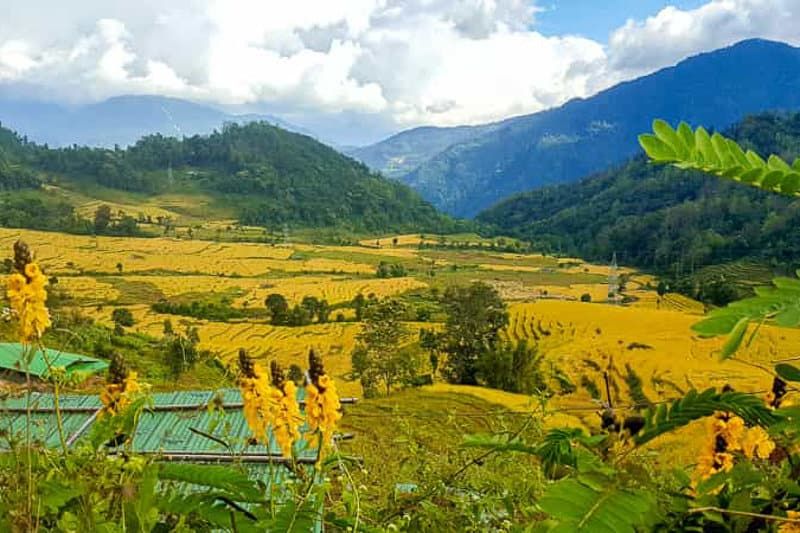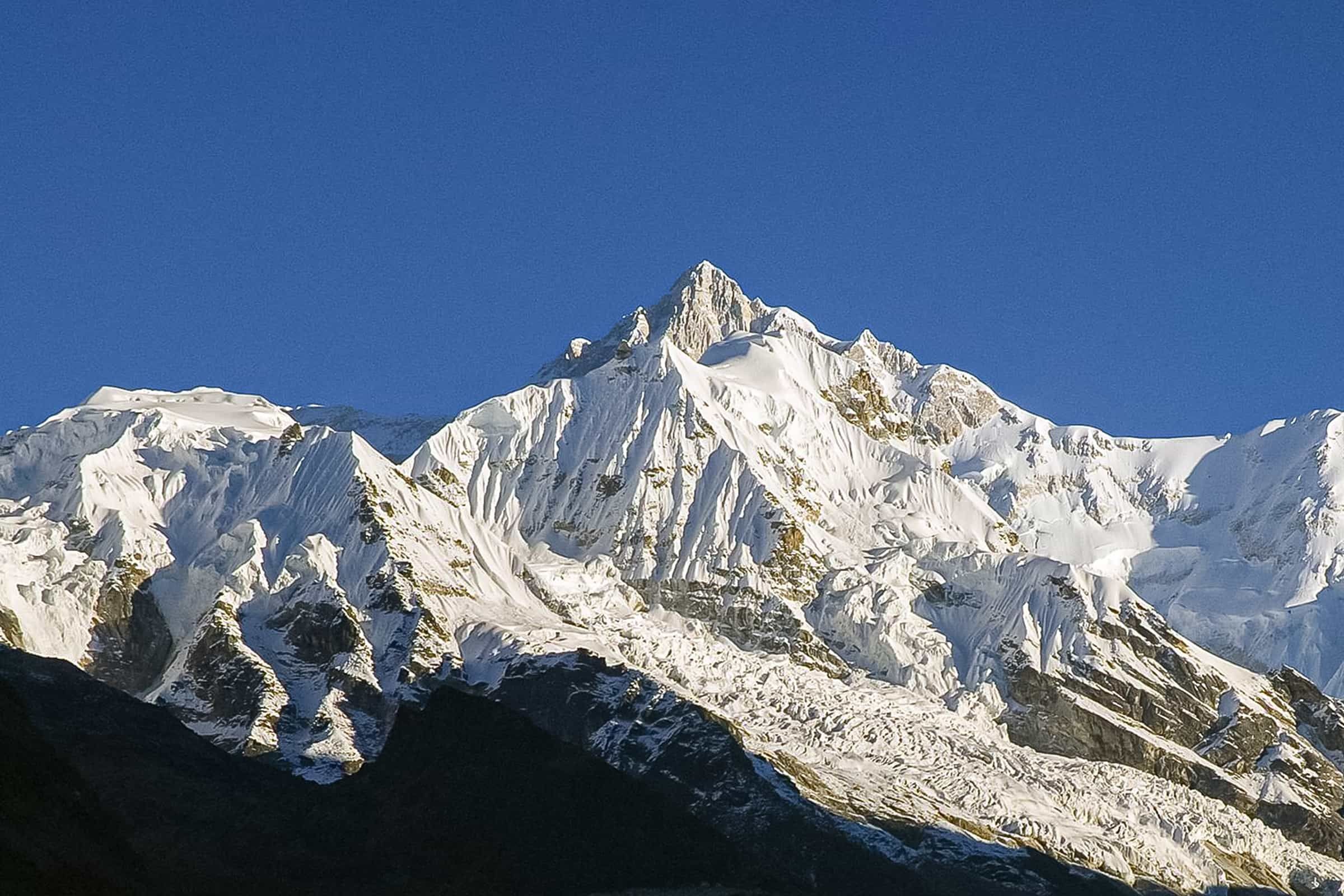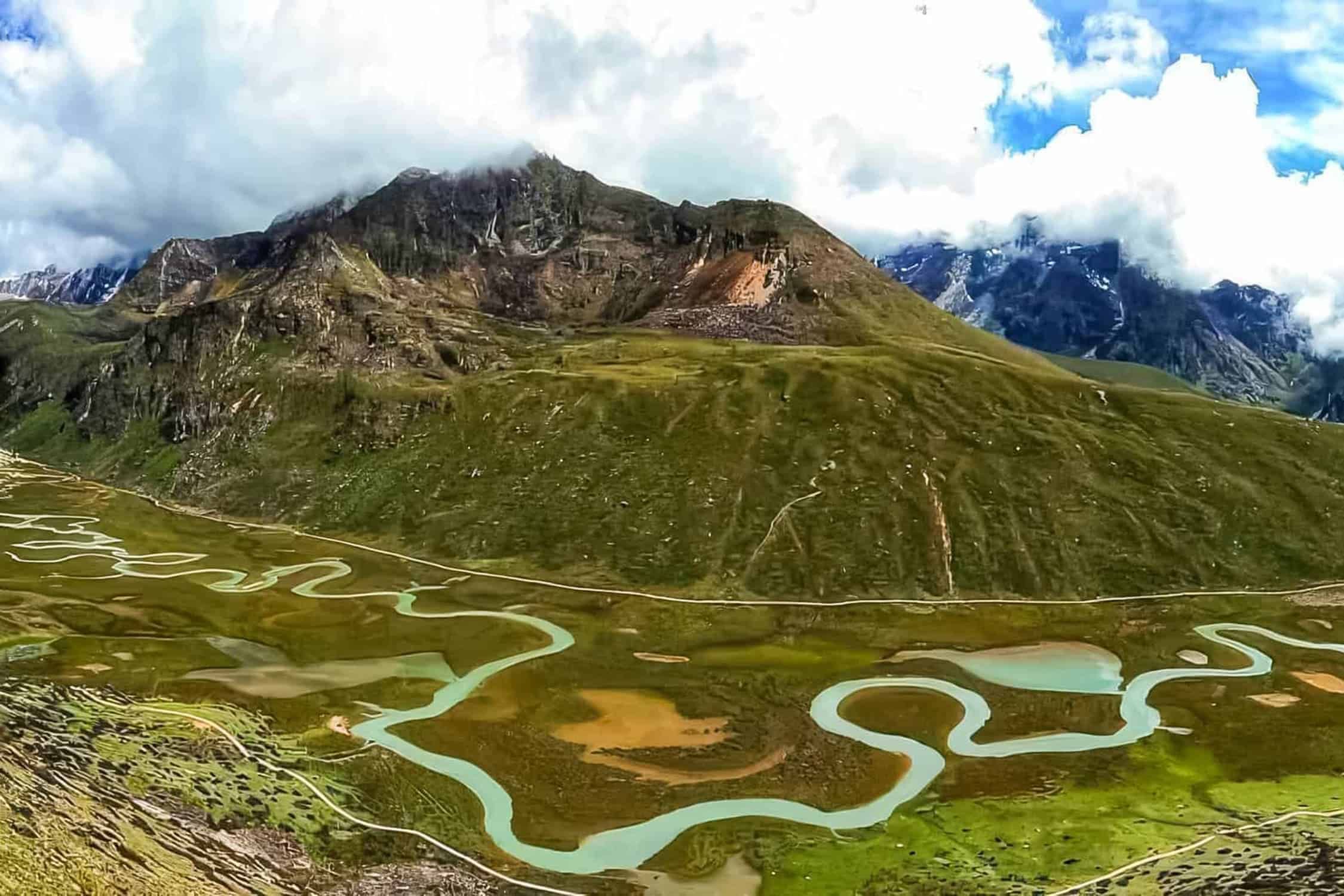Singelela-Goechela trekking: To the foot of Kangchendzönga

Group trips – Trekking (tent)
Demanding to very demanding
9 x
11 x
4,950m
We also offer all of our tours as private tours – at your best time and with your desired program.
Contact us – we will be happy to help you.
Short description
The 8,586 metre high Kangchendzönga is the third highest mountain in the world. It rises majestically above Sikkim. This 8,000 meter peak marks the border between Sikkim and Nepal. We will go on an exciting circular trek on an unusual route to this mighty ice giant. The way there follows the old shepherd’s paths, and on the way back, we will take the classic route. On our journey, we will enjoy the fantastic mountain panorama with numerous snow and ice peaks. The highest point of our trek is the Goecha La, which is almost 5,000 meters high. Here we will have the third highest mountain in the world within our grasp.
In terms of landscape, Sikkim is one of the most varied regions in the Himalayas. Below the high snow peaks, Sikkim is a very green botanical paradise with dense forests, rhododendrons, orchids and giant ferns. The former kingdom of Sikkim, which now belongs to India, lies between Nepal and Bhutan as well as India and Tibet and is also very culturally multifaceted. Before and after the trek, we will visit the most exciting places in Sikkim.
Highlights
- 22 day trekking on ancient paths of the Yak herders
- Beautiful view of the 8, 586 meter high Kangchendzönga
- Crossing several passes between 4,000 and 4,950 meters
- Large monasteries and small villages
- Former Kingdom of Sikkim

Book with us
of experience on site.
Important information
Air fares
Important note: The costs are based on a Zurich-Delhi return flight price of CHF 750, which has been the average flight price in recent years. Since the recent world crisis and energy crisis, flight prices have fluctuated greatly and can also be significantly higher, especially if you book your flight not far in advance. We will charge the actual flight prices at the time of booking. If the flight costs are lower than CHF 750, the travel price will be reduced by the difference and if they are higher, the travel price will be increased. It is also possible to book the flights yourself. In this case, CHF 750 will be deducted from the tour price.
We recommend booking the tour early. Flights are often half the price or less compared to last-minute flight bookings.
Single room/tent
It is possible to book a single room and tent for a surcharge. In some accommodations (depending on the tour in small hotels, guesthouses, with local families or in monasteries), space is often limited and a single room cannot be guaranteed. This applies in particular to lodges in Nepal, where there are usually no single rooms available at all. This circumstance is taken into account in the single room supplement and does not entitle you to a price reduction.
If you would like a double room/tent but no room partner of the same sex can be found, you will receive a single room/tent. In this case, Himalaya Tours will pay half of the supplement and you will only be charged half.
Travel program
Meals included: breakfast (B), lunch (L), dinner(D)
Flight to Delhi
Flight to Delhi, the capital of India. On arrival, passport control and baggage collection. Our local partner is waiting at the exit with “Himalaya Tours” sign. He will organize the transfer to the hotel or for your flight to your destination.
Note: Depending on the flight connection and arrival time in Delhi, we will spend the night here in a hotel or fly on to Bagdogra and spend the night in Shiliguri.
Overnight stay in a hotel in Delhi.
Total flight time 8-11 hours. Either with a direct flight or two flights with one change.
Flight along the Himalayas
On day 2 we will fly along the Himalayas to Bagdogra. In fine weather, we can see the 8,000-metre peaks of Dhaulagiri, Annapurna, Everest and Kangchendzönga. Our journey to Sikkim will first take us through the lowlands, then we cross a dense forest area and cross the Tista River, whose source lies in the border area with Tibet in northern Sikkim. This will be followed by a varied ride past terraced rice fields and lush green subtropical forests. We will pass tiny hamlets, bustling villages and deserted jungles inhabited only by communities of monkeys. We will reach the day’s destination, Gangtok, which is built on a hillside. This is Sikkim’s capital.
Overnight stay in a hotel in Gangtok (1,650 m). (B, L, D)
Flight time 2½ h, travel time 5 h
Gangtok – capital of Sikkim
After our long journey, we will take it easy on day 3. We will set off on foot to the Gangtok bazaar. We enjoy the hustle and bustle and maybe even make a deal or two. The Institute of Tibetology has one of the finest collections of Buddhist literature, as well as a large number of thangkas, bronze figures and cult objects. From there we will continue to the Do-Drul Chörten. Traditional crafts are taught at the Cottage Industries Institute. Traditional wood carvings, textiles and bamboo items are also available here.
Overnight stay at the hotel in Gangtok (1,650 m). (B, L, D)
Drive time 1 h, hike 1 ½ h
Sikkim’s indigenous people and shaman ceremony
After breakfast, we will drive to Rumtek on the opposite side of the valley. From our accommodation, we will take a hike on narrow paths across terraced rice fields to a small indigenous settlement. We will walk through the village and gain an insight into village and rural life. We will be invited to visit the village shaman in a house built on stilts. Here we will be allowed to observe a ceremony and enjoy a cup of tea together. We will then visit the Lingdum Zurman Kharwang monastery. Inside the colorful complex, the murals tell of important events in the life of the Buddha. The cosmopolitan monastery also has an active monks’ school. The young monks can often be found memorizing the Tibetan alphabet or reciting mantras (powerful prayers).
Overnight stay at the hotel in Rumtek (1,350 m). (B, L, D)
Drive time 1 h, hike 2-5 h
Varied culture
On day 5, the Kagyu monasteries of Rumtek will be on the program. The 16th Karmapa, head of the Kagyu order of Tibetan Buddhism, lived here from 1959 to 1981. After fleeing to Sikkim due to the Chinese invasion of Tibet, he not only received asylum from the King of Sikkim, but also land and support for the construction of a new monastery in Rumtek. His home monastery in Tsurphu in Tibet served as the model for the building. During the 16th Karmapa’s lifetime, the monastery was an important pilgrimage site for Tibetan Buddhists. The Karmapa is one of the most important reincarnations in the Tibetan Buddhist world and the head of the Karma Kagyu school. The Karma Kagyu school is one of the four main branches of Tibetan Buddhism. The Dalai Lama is the head of the Gelugpa (Yellow Caps) school.
If you follow the road lined with prayer flags, you will come to the original old monastery of Rumtek, built in 1734. It exudes a wonderful sense of tranquillity and is situated on a mountain ridge with a fantastic view of the hills and fields of Martam. A small shrine in an adjoining room is dedicated to the protector of the Kagyu school, Mahakala. However, the figure is covered because of its powerful effect. Afterwards, a varied drive will take us first through the largest tea garden in Sikkim. The Temi tea garden is known for its excellent, organically grown tea and is an insider tip among connoisseurs. The journey will then continues uphill to the town of Ravangla. In the evening we will reach a typical Bhutia village. Here we will be guests in the home of a family and immerse ourselves in the culture of the Bhutia Sikkimese, who originally come from Tibet. We will end the evening with a traditional Bhutia dinner in the simple kitchen of our host family, followed by a small cultural performance around the campfire. Of course, a “Chang”, a home-brewed beer made from millet, is a must.
Overnight stay in an simple family house in Kewzing (1,550 m). (B, L, D)
Driving time 4-5 h, hike 1-2 h
«Freed from all our sins»
After a leisurely breakfast with the family, we will have time to explore the village of Kewzing. As we continue our journey, we will visit the Tashiding Monastery, which stands on a cone-shaped mountain. Next to the monastery, there are several chortens. It is said that just seeing these chortens frees us from all our sins. We can try this out! The prayer walls with the mantras artfully carved in stone are beautiful. Unfortunately, the stonemason who created all these works of art passed away a few years ago and it is often difficult to find successors for this ancient craft. We will drive past villages which are mainly inhabited by Nepalese ethnic groups. At the village of Rinchenpong, a dirt road leads the last kilometer to our accommodation, a typical Bhutia farmhouse. If we feel like it and don’t arrive too late, we will take a half-hour hike to a viewpoint near the farmhouse.
Overnight stay in an simple farmhouse lodge in Rinchenpong (1,600 m). (B, L, D)
Drive time 2-3 h, hike 1-2 h
Trekking start
We will set off early on day 7. After an hour and a half drive, we will reach Uttare, where we will begin our trek. Our crew will be already waiting for us. All the luggage will be carried by horses or yaks, so it will take a moment to load everything onto the pack animals. We will set off uphill through dense forest on a narrow paved path along the Simphok Chu stream. Since this will be our first day of trekking, it will be particularly important not to set off too quickly. We will reach a clearing in the forest with several houses, Alp Chitre. The last section up to the top of the pass on the Singalila Range is steep and we will have to earn the breathtaking view. This is right on the border with Nepal, and on a clear day we can enjoy a spectacular panorama westwards to Nepal and eastwards to Sikkim. We will stay in Chewa Bhanjyang for the next two nights. This will be important to get acclimated to the elevation, which is over 3,000 meters in altitude.
Overnight stay in a tent in Khiva Bhangjang (3,200 m). (B, L, D)
Driving time 1½ h, trekking 4-5 h, ascent 1,050 m, descent 50 m, walking distance 7 km
Ascent of Singalila Peak
We will have the opportunity to hike southwards along the Singalila ridge up to Singalila Peak (3,685 m). On a clear day, we will be rewarded with a tremendous view of the surrounding 7,000 and 8,000 meter peaks. In the north, this is the third highest mountain in the world, Kangchendzönga. The name Kangchendzönga comes from the Tibetan language and can be translated as “The Five Treasuries of the Great Snow”. The hike will be optional and it will be possible to spend a day of “dolce far niente” at the camp instead and to enjoy the mountain panorama from there and acclimatize to the altitude. We can relax in the camp and enjoy the magnificent mountain scenery.
Overnight stay in a tent in Khiwa Bhangjang (3,200 m). (B, L, D)
Optional hike of 4-5 h
Continuing to the north
Well recovered, we will continue today. We will climb northbound along the ridge of Singalila and hike through large rhododendron forests. These only bloom in springtime. Our path will lead us up and down and always along the border, with Nepal on the left and Sikkim on the right. The snow and ice peaks of Bhutan can also be seen in the distance to the east. After a long day of trekking, we will reach our camp.
Overnight stay in a tent in Dhor (3,700 m). (B,L,D)
Trekking 6-7 h, ascent 850 m, descent 350 m, walking distance 14.5 km
Sunrise over the Himalayas
The 9th day of our travels was pretty long, and day 10 will be a bit shorter, but it is still worth getting up early. We will climb up to a viewpoint before sunrise. If the weather is clear, we can see from here how the first rays of sunlight reach Kangchendzönga, Mount Everest and many other mountain peaks. We will continue along the mountain ridge. We hike over several small passes and marvel at the fabulous panorama around us. Shortly before reaching the shepherd’s settlement of Pare Megu, we will cross the last and highest pass of the day. At the top of the pass, colorful prayer flags flutter in the wind and it said that they carry prayers to the gods who live on the Himalayan peaks. Our camp will be just a little further down in the flat pastureland on Nepalese soil.
Overnight stay in a tent in Pare Megu (3,900 m). (B, L, D)
Trekking 4 – 5 h, ascent 450 m, descent 250 m, walking distance 8 km
Past the mountain lakes
We will be trekking along the border of Sikkim and Nepal on day 11 and the trail will take us partially to the Nepalese side. From the camp we will climb up to another pass. The landscape now will open up and the tree line will be below us. Passing small mountain lakes, we will reach our camp on the banks of the Lam Pokhari mountain lake, on Indian soil. We will sleep at an altitude of over 4,000 meters for the first time.
Overnight stay in a tent at the Lam Pokhari mountain lake (4,300 meters). (B, L, D)
Trekking 4-5 h, ascent 650 m, descent 250 m, walking distance 8 km
Our first high pass
Up to this point, we will have already crossed a number of mostly smaller passes. But on this day, our first high pass is on the agenda. From the camp, we will head up to the Daphebir Pass. This has an altitude of 4,600 meters. We will repeatedly have beautiful views of the mountain giants in front of us, which we will get closer and closer to. On the descent from the pass, we will reach the tree line again and the last stretch of our hike will be through the forest to the Gomathang clearing. We will set up camp on this grazing ground of the local Yak herders.
Overnight stay in a tent in Gomathang (3,800 meters). (B, L, D)
Trekking 5-6 h, ascent 300 m, descent 800 m, walking distance 6 km
Forests and pheasants
After spending the night below 4,000 meters, on this day we will be hiking mostly uphill.As we start off the day with an ascent over wooded slopes, it will be worth keeping an eye open for birds. With a bit of luck, we might encounter Himalayan glossy pheasants or blood pheasants. The latter is Sikkim’s national bird. The Kokling Pass at 4,250 meters is the highest point for the day. After descending from the pass, we will climb back up to our campsite in Pangding.
Overnight stay in a tent in Pangding (4,300 meters). (B, L, D)
Trekking 6h, ascent 800 m, descent 300 m, walking distance 10km
Fantastic mountain panorama
From Pangding, we will climb into a side valley where we will cross a mountain stream and then set off on the leisurely ascent to Dzongri. Numerous colorful prayer flags flutter in the wind here, marking the place where the gods meet the earth, the people and the yaks. From up here we will have a wonderful view of the surrounding mountain panorama. Not only Kangchendzönga can be seen on a clear day, but also the 6000 meter peaks of Kokthang, Rathong and Kabru Dome. We will pitch our tents on a beautiful alpine meadow. If you still have some energy and desire, you can climb to the 300 meter higher Dzongri Peak for an even better view of the mountain panorama. From here onwards, we will be on the main route of the Goecha La trek and so the next few days will not be as lonely as the previous ones.
Overnight stay in a tent in Dzongri (4,000 meters). (B, L, D)
Trekking 3½ – 4h, ascent 600 m, descent 900 m, walking distance 10 km, optional hike 2-3 h
Turquoise-blue Lake Samiti
We will mainly hike up the valley and will continue over some glacier moraines to our camp in Lamuney at around 4,200 meters. Here we can take a trip to the turquoise blue Lake Samiti, which we will reach in around 45 minutes. Due to environmental reasons, overnight stays are currently not permitted. It is a very charming place, surrounded by rhododendrons and fir trees. If we prefer to rest a little after arriving at the camp, we will have another opportunity to see Lake Samiti on day 16 on the way to Goecha La.
Overnight stay in a tent in Lamuney (4,100 m). (B, L, D)
Trekking 5-6 h, ascent 450 m, descent 350 m, walking distance 8km, optional hike to the lake 2h
Up to Goecha La (4950 meters)
We will start early in the morning to admire the sunrise from the first good vantage point, to an altitude of 4,700 meters. This is often the last permitted point for trekkers. However, depending on the conditions, we may even be allowed to go all the way up to the 4,950 meter high Goecha La. At the top of the pass, colorful prayer flags flutter in the wind, carrying prayers to the gods on the summits. We will enjoy the silence and the view of the third highest mountain on earth. Thanks to our early start, we will have some extra time to spend up here. This will be followed by a long descent back to Thangshing, where our cook will be waiting with a delicious snack for us.
Overnight stay in a tent in Thangshing (3,950 m). (B, L, D)
Trekking 7-9 h, ascent 850 m, descent 950 m, walking distance 19.5 km
On narrow paths down to Tsokha
After days of trekking in uninhabited mountain terrain, we will reach a permanent settlement again for the first time, the village of Tsokha. This former Tibetan village was founded in 1961 by Tibetan refugees, but is no longer inhabited today. Situated on a small plateau, the village offers a beautiful view over the surrounding hills and valleys. On a clear day we can see the almost 6,700 meter high mountain Pandim. We will be able to enjoy the “thicker air” and warmth down there at 3,000 meters. We will sleep one last night in our tents.
Overnight stay in a tent in Tsokha (3,050 m). (B, L, D)
Trekking 6-7 h, ascent 200 m, descent 1,100 m, walking distance 11.5 km
Back to Yuksom
We will walk downhill through the narrow Rathong Valley. The path will lead us through partly dense, semi-tropical forest and is a nice contrast to the previous days in the stony heights of the pass. Back in Yuksom, we will celebrate our successful trek with our local team, perhaps with a “Chang”, a home-brewed beer made from millet.
Overnight stay at the guesthouse in Yuksom (1,750 m). (B, L, D)
Trekking 6-7 h, ascent 150 m, descent 1,400 m, walking distance 11.5 km
Sacred wishing lake Khecheopalri
On the morning of day 19, we will visit the coronation site of the first king of Sikkim. A small temple and a huge stupa herald the place where the empire was founded. We will take a walk to the Norbugang Chörten, the most sacred place where the coronation of the 1st king took place in 1642. Under a gigantic cedar tree (Cupressus cashmeriana) stands the stone throne on which Chogyal Phuntsok Namgyal was crowned King of Sikkim by three lamas from Tibet. Lhatshun Chempo gave the king his ancestral name, Namgyal – this was the beginning of the Namgyal dynasty. On our onward journey to Pelling, we will take a beautiful hike, mostly uphill to the sacred, wish-fulfilling Khecheopalri Lake. We will pass small villages, terraced fields and plantations where cardamom is grown. The original name of the lake was Kha-Chot-Palri, which translates as the “heaven of Guru Padmasambhava”. The small, legendary lake is sacred to both Buddhists and Hindus. From the end point, we will continue through a varied landscape of terraced rice fields and remote settlements to a Sikkimese guesthouse below Pelling.
Overnight stay at the guesthouse below Pelling (1,700 meters). (B, L, D)
Driving time 3-4 h, hike 3-4 h
Large statues, temples and rice fields
If the weather is fine, it will be worth getting up early today and driving to the Nyingma monastery Sanga Chöling before breakfast. From there, we will enjoy another wonderful view of Kangchendzönga and other snow-capped mountain peaks. From the monastery, we will walk to the Chenrezig statue, which was completed in fall 2018. The newly built complex also includes a skywalk and a gallery inside the statue. At a height of 41 meters, it is the tallest of the three large statues in Sikkim. After breakfast at the guesthouse, we will visit the famous 18th century Pemayangtse Monastery with its unique wooden sculpture carved out of wood. The monastery was involved in the royal government during kingdom times and played an important role. Its name means “the all-encompassing, perfect lotus”. Around midday, we will drive on to Turuk in the south of Sikkim. If we feel like it, we will visit the third and oldest of the three large statues, the statue of Guru Padmasambhava on Samdruptse Hill, before Namchi.
In Turuk, we will be guests in the family home of a Pradhan family who originally immigrated from Nepal.
Overnight stay in the family house in Turuk (1,200 meters). (B, L, D)
Drive time 5h, hike 2h
Back to Delhi
On this morning we will drive to Bagdogra, where our journey comes full circle. From here we fly back to Delhi. We will be hoping for good visibility so that we can admire the Himalayas and their high peaks once again. In Delhi, we have a “wash andchange room” at our disposal, where we can freshen up for the flight back to Switzerland.
In the afternoon/evening (depending on the flight connection), we will drive to the airport, where we will check in for our return flight to Switzerland.
Day room at the hotel in Delhi. (B, L, D)
Flight time 2½ h, travel time 3-4 h.
Back to Switzerland
Flight from Delhi to Zurich. We will be back with lots of impressions and experiences in our luggage.
Total flight time 8–11 hours, with either a direct flight or two flights with one stopover.
The times given are generally pure driving or walking times. Breaks, stops etc. are also included. The times given are average values based on experience, but may vary depending on road, trail and weather conditions, the fitness of the participants or for other reasons.
The altitude data (for trekking tours) are based on satellite data. These may vary due to walking alternative routes, climbing additional viewpoints, detours due to weather or trail conditions, etc.
We expressly reserve the right to make changes to the program (due to road, trail and weather conditions, flight delays, instructions from the authorities, water levels or occurrence on the trekking route, etc.)!
Further information
- Tour guide
- Requirements
- Accommodation
- Overnight stay with local families
- Overnight stay in a tent during the trek
- Food and drinks
- Services included
- Services not included
Tour guide
This tour is led by a local English-speaking guide. He knows the country, its people and customs and will also translate for us if we come into contact with locals along the way. They often don’t speak English.
Requirements
- An easy tour with day hikes of 1 – 4 hours (optional extension 1 – 6 hours). All hikes are optional and can also be omitted.
- The hikes are easy to moderately difficult (analogous to red and white marked mountain trails), in bad weather it can also be slippery, good hiking boots are recommended.
- We carry our own daypacks on the hikes.
- Overland trips of 1 – 5 hours, 1 full-day stage.
- Empathy, flexibility and no fear of contact in easy conditions.
Accommodation
In Delhi, Gangtok and Rumtek we spend the night in a good guesthouse or mid-range hotel. In other places, the accommodation is much easier. We stay in small hotels or easy guesthouses. WC and shower are usually in the room (in exceptional cases on the floor). We try to find the “best” accommodation in each case.
Overnight stay with local families
When staying with local families, we should not expect any luxury. The bed is easy, the toilet is outside the room and there is only an oven for heating in the kitchen. Meals are prepared by the local family and we have the opportunity to enjoy truly local food.
Our expectations of comfort should be rather modest, but in return we have an insight into the life of a local family that is unfortunately denied to most travelers.
Overnight stay in a tent during the trek
On the trek, we spend the night in dome tents with two side entrances from Jack Wolfskin. Luggage can be stored in the awning or inside the tent. We have tested most of the models available and the one we have chosen is the best compromise in terms of comfort, wind stability and ease of pitching.
We have also included a dining, cooking and toilet tent. Folding chairs and tables are available, as sitting on the ground for long periods of time is usually tiring for us Europeans. Of course, we also have all the crockery, cutlery, cups etc. with us.
Food and drinks
In the hotels and restaurants we have various vegetarian dishes and often also dishes with meat to choose from. During the trek, we will eat mostly vegetarian food. However, there are also generally various dishes to choose from. We take lunch with us as a cold lunch, but it can also be a hot meal prepared in the morning, which we carry with us in thermos flasks.
Drinks in the hotels and restaurants are not included (except breakfast drinks). Boiled water or tea can be bottled during the trek, and we also have a Katadyn water filter with us. Tea, coffee (instant) and hot chocolate are also available with meals on the trek.
Services included
- Flights Zurich-Delhi return in economy class
- Flights Delhi-Bagdogra return in economy class
- Airport taxes and fuel surcharge
- All overland travel and transfers
- 6 nights in a hotel/guesthouse in a double room
- 2 nights in an easy family house
- 1 overnight stay in an easy farmhouse lodge
- 11 nights in a double tent during the trekking
- 1 day room in Delhi on the return journey
- Breakfast, lunch and dinner during the tour, breakfast only in Delhi
- Entrance fees for sightseeing as per program
- Special permit for Sikkim
- Comfortable sleeping tents, dining, cooking and toilet tents, folding tables and chairs, cooking utensils and dishes
- Local English-speaking tour guide plus accompanying team during the trek
- Extensive emergency first-aid kit
- Pulse oximeter for measuring oxygen in the blood
- Oxygen bottle
- Water filter from Katadyn
- 24h-SOS phone from Himalaya Tours in Switzerland and our local partner on site
- E visa for India plus obtaining
- Completion of all formalities for India
- Preparation meeting
- Map of Sikkim
- Platypus bag to be used as bed and drink bottle
- Hot bed bottle on cold nights
Services not included
- Drinks (CHF 120 – 180 per person, depending on the number of participants, possibly slightly higher for small groups)
- Lunch and dinner in Delhi
- Drinks in restaurants, hotels and guesthouses
